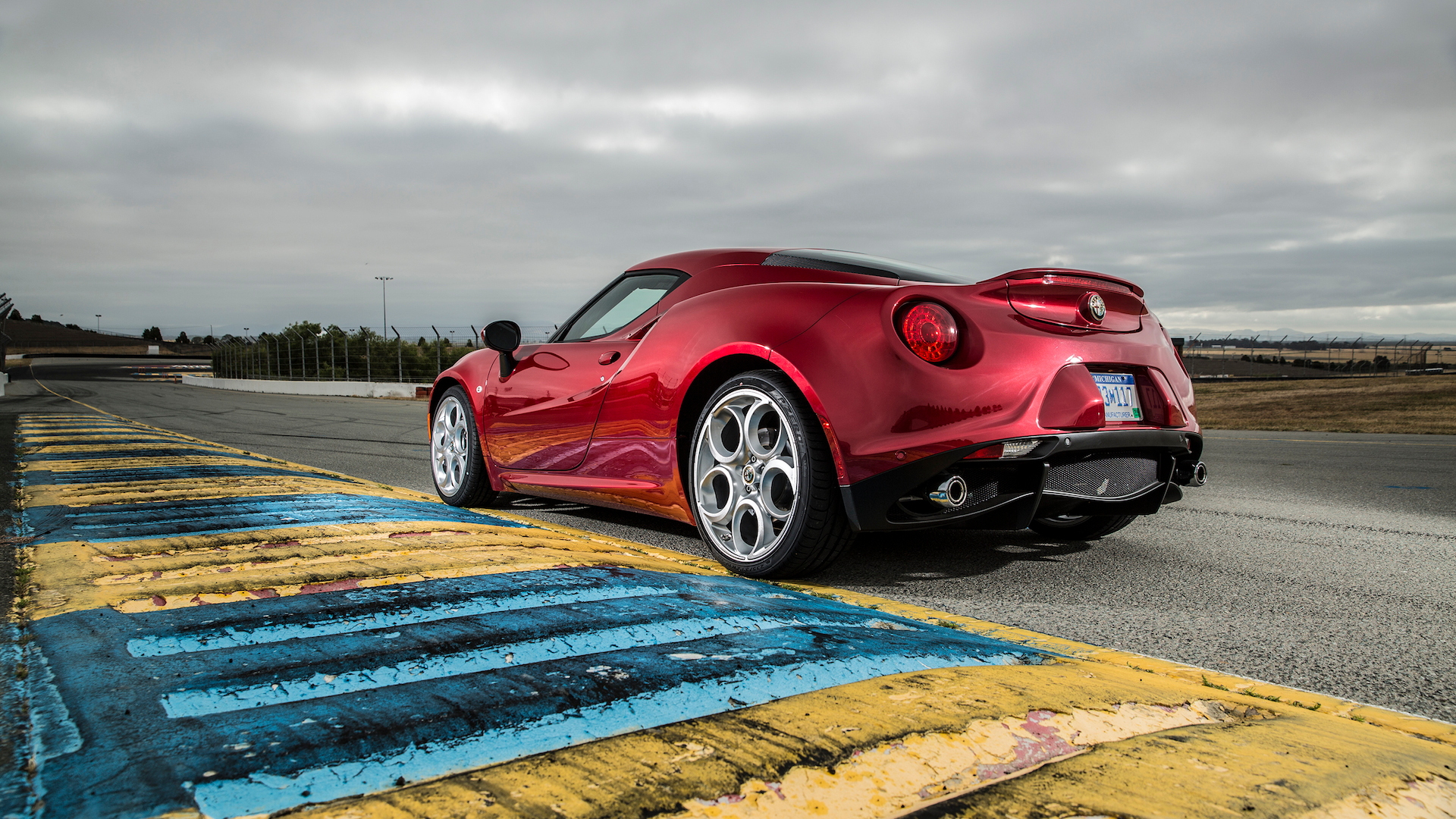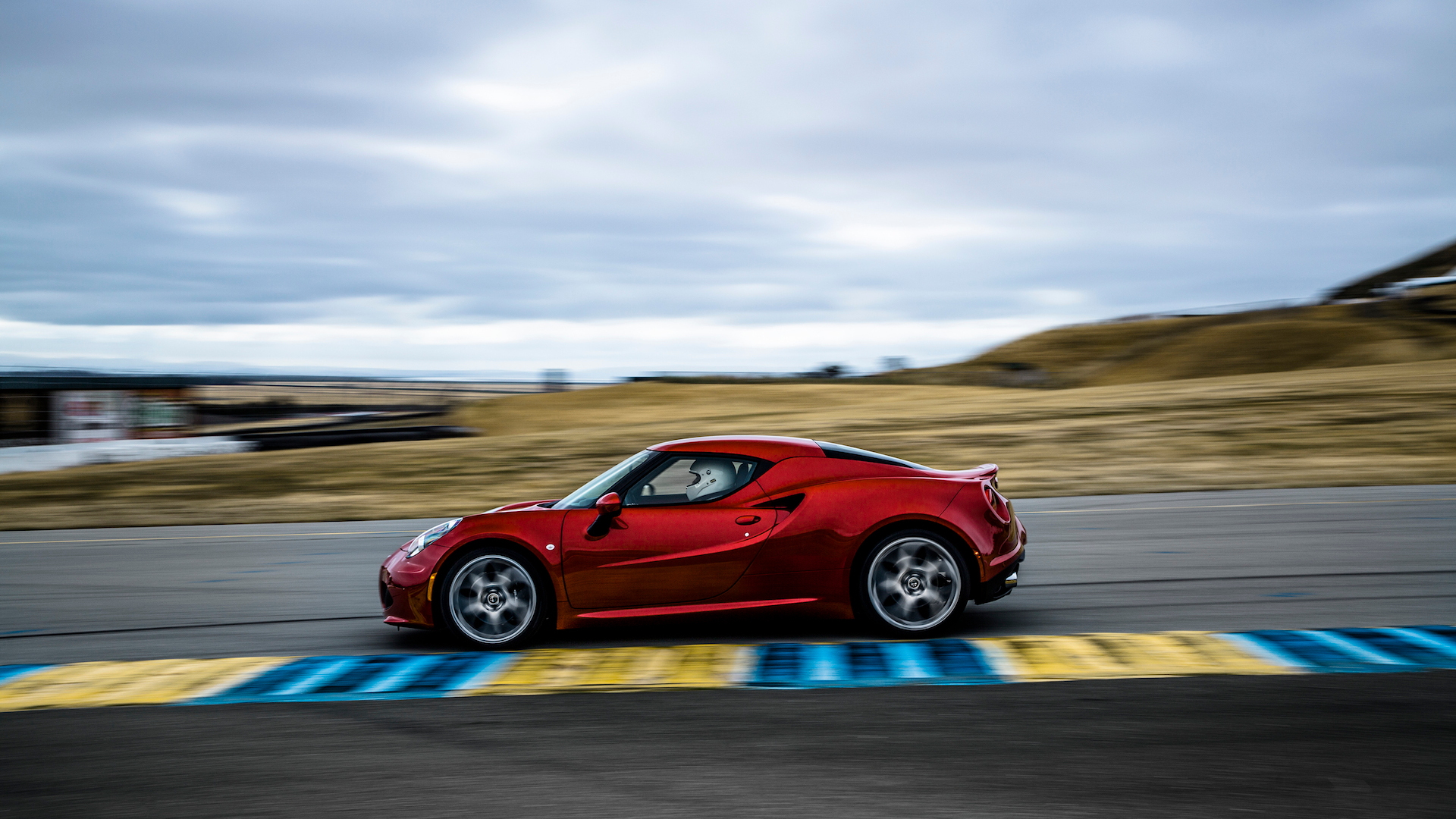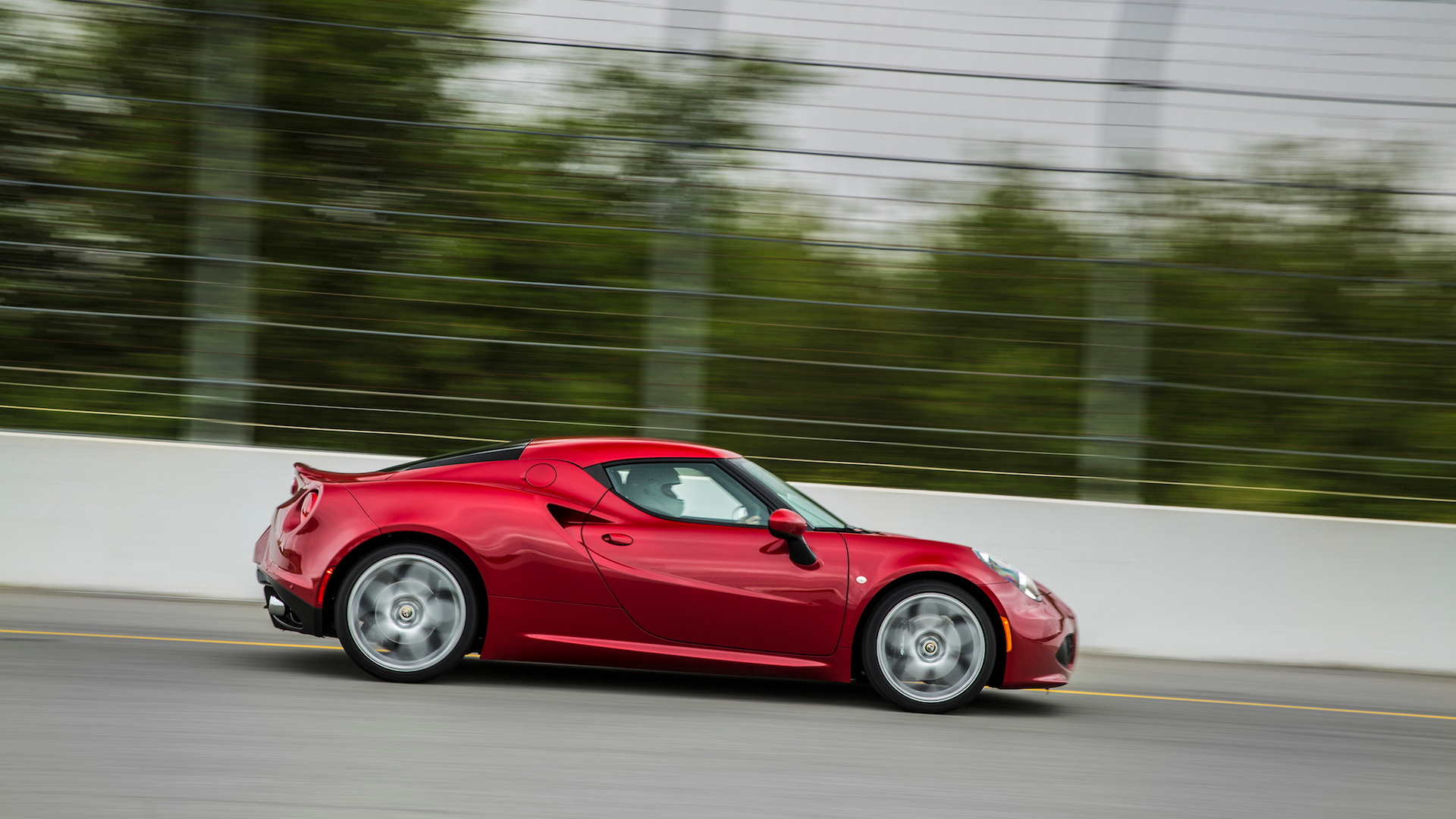Quick--ignore these unabashedly erotic images, pretend you never saw a thing...and name this car.
It’s a mid-engined two-seater not from Germany or Japan. It flaunts a supercar monocoque and a humbler suspension. It cauterizes corners courtesy a dual-clutch gearbox and turbocharged power. It's exotically shaped from equally exotic materials.
It doesn't wear a Lotus badge, or a Ferrari one. But it could, easily.
It’s the Alfa Romeo 4C, and it’s set to kick off the brand’s U.S. revival later this year.
MUST SEE: Jaguar XJ220 Lights Tires On Fire In Ultimate Burnout: Video
Alfa Romeo hasn't sold a car here in decades--and its last exit was an inglorious one, a dribble of Saab-based 164 sedans and a handful of aged Spider convertibles. (You want to talk about the 8C, right? No.) Now it's back, under the hopeful guard of Fiat Chrysler Automobiles, with the 4C.
Alfa Romeo and Maserati CEO Harald Wester promises the 4C is the closest experience to a motorcycle on the road.
"It feels like you're wearing the car," Wester says. It's the "purest reincarnation of what Alfa stood for."
Memories of rod-throwing Milanos shucked, we see what he's going for here. Dynamically imperfect but damn close to it, visually a virtual outline of vintage racing hotness, the Alfa Romeo 4C is a limited-run come-on that's basically been fabricated out of thin air for a singular purpose. To make some noise.
Looks a million
While it's on the way to that glorious racket, the Alfa 4C kicks up serious styling stardust. A singularly stunning car, the 4C has emerged from concept-car fantasy to reality without a sin committed—calling up lots of panache in the process.
Low-slung and outrageously sexy,the 4C is a car that makes you pay attention. Alfa says it's inspired by the '67 Alfa 33 Stradale, but we can't help think Dino either--and in truth, the 4C's dimensions are a little closer to that ersatz Ferrari anyway. Put a prancing horse and a $100,000 pricetag on it, and it would look authentic except at the front, where the beaky overbite sets the Alfa tone. (That deep vee will look terrible behind a front license plate.)
Keep studying it. Those side air scoops could not be more artfully drawn. The cat-eye side glass mimics them perfectly. The rear end's capped in mic-dropping round LED lamps.
The 4C wants you to see all its guts and glory in gory detail. Its turbo heart kept under the rear glass, like a specimen. The interior's stark and there's slashes of red everywhere. Make your own Game of Thrones joke. The steering wheel's flat-bottom grin is a frozen S-Class-style rictus. Even the key fob is lacquered in a hemoglobin red.
In other places, the 4C is remorselessly low-rent, unless you know what you're looking at. It is not about cosseting, it is the opposite of that. That's why the plastics are a half-dozen grains, but they're textured to look like the road surface. The center tunnel is the car's carbon-fiber structure, not chintzy trim. The air vents are faired in a more thoughtful way, but the A/C box underneath it looks exactly like the tacked-on part that it is. The gauges are a 7-inch LCD display that shifts color according to the mode of the road ahead--where yellow and red can mean both fun and danger.
Don't say dart
I drove the 4C from San Francisco to Sonoma Raceway, for the best taste yet of Alfa’s latest. With training wheels put on its tougher corners--seriously, a whole downhill passage of car-rotating esses cut from the program--Sonoma still found a way to pan for the 4C's handling gold, and a little of the accompanying dust.
The 4C has some incredibly talented challengers in its price class in the Porsche Cayman, the Mercedes-Benz CLA45 AMG, even the Chevy Corvette and Jaguar F-Type. It's a murderer's row.
The Alfa carves out its own niche with a body closer than any of those to supercar standards. The body is wrapped around a tub made from carbon fiber, slow-baked sheets instead of fibers molded into resin. No big thing, but that's kind of how they make the LaFerrari.
Power comes from a direct-injected and turbocharged 1.7-liter four-cylinder engine, rated at 237 horsepower and 258 pound-feet of torque. There's a lot of racket to be spooled up here--a leafblower thrum about a foot behind and to the left of your ear that honestly sounds a lot better from the outside of the car. Also, that may not seem like a lot, but each of those horses has just 10.3 pounds to carry, derived from its final curb weight of about 2,495 pounds--heavier than Euro-spec thanks to standard air conditioning and airbags.
Launch control mode is accessed through the six-speed twin-clutch's shift paddles, but at this weight and size, every launch feels like it needs some control. Rip out of the pits, nip off the edge of the left-hander under the bridge, and even uphill, the little Alfa's 0-60 times pegged at four and a half seconds feel easily within reach. It kicks out a raucous howl when the Race Exhaust option kicks off the muffler, letting its bratty side run wild. Alfa Romeo boasts about the engine's ‘scavenging control system’ that it says eradicates any turbo lag, but it doesn't act that way. The lag's still there, on the street and on Sonoma's tighter corners, basically anywhere it's not wound out in a way that would attract calls to 911.
The rear-drive 4C comes only with a six-speed dual-clutch gearbox. If you’re missing a true stick shift, you’re missing the point—the 4C’s dual-clutch works really well on this track and on the street, where a manual would erase the little bit of room available in the pedal box. The cockpit would be a festival of flying elbows. The twin-clutch is almost perfect--and picks up the shift pace via a “DNA” switch that alters its ego and gauge colors from dynamic (red), to natural (grey), to all-weather (blue) shift and throttle settings.There's also the yellow-screen Race mode that turns off the stability control, but that’s not a great idea on a fast track with a mid-engine car on oversized tires.
I do it anyway for a couple of laps. The Alfa's ride and handling are meant for times and places like this, where the lightweight aluminum suspension and tires have room to work and play. The setup features double wishbones in front and MacPherson struts in the back--a Dodge Dart suspension flipped 180 degrees is conceptually similar, but the Alfa's stiffer aluminum pieces and substantially different geometry don't feel like distant cousins. Even over the Golden Gate Bridge's juddery expansion joints, the 4C's ride was more than tolerable.
Outfitted with the Track package's stiffer anti-roll bars and shocks, the 4C just sits and sticks through Sonoma's small half-carousels. It only feints a breakaway when the weight's transferring all up front and you're for some reason still into the brakes. Which you shouldn't be. I write that one on my cortex, for future reference.
The manual steering is a workout. It lightens up beautifully at speed, but in low-speed corners, it takes a lot of muscle and more wheel turning to screw into a corner properly. The 15.7:1-ratio steering is no darty piece like an Exige. You can brace an elbow on a door panel to keep the line around Sonoma's widest, longest right-hander.
The brakes are made by Brembo, four-pistoned and vented in front. The tires are staggered; stocks are Pirelli P Zero ARs, 205/45ZR-17 front, 235/40ZR-18 rear--a three-season setup, winter not welcome--or 205/40ZR-18 fronts, 235-35ZR-19s in back, the standard setup on Launch Edition 4Cs. The stopping power is ferocious, but on the street and on Sonoma, the 4C's brake pedal felt hard and a little tough to modulate, not a lot of travel to it.
Those are minor flaws, forgivable ones. After a few laps, you can’t help but get hot and heavy with this car. It’s an intimate relationship for sure—though it’s also one that’s really hard to keep on the down low.
Dino, sore
It's a game of Operation, extracting myself from the 4C, even without the helmet and now-skanky balaclava. This Rocky Horror dance move demands a certain sequence. It's just a step to the right, then swing your hips, then...then yank your other foot in and hope no one's watching you go down this particular runway plumber-style.
Here's my excuse. The 4C's only 157.5 inches long, with a 93.7-inch wheelbase. It's 73.5 inches wide, and--the killer--it sits just 46.6 inches high. You plop into it, and climb back up to the surface of the Earth to get out. Its 38 inches of headroom is better than a Camaro, but it's still easier to take the helmet off first, then leave with a little dignity.
You won't soon forget an exhilarating run around Sonoma, and some of that is because of the pinching you'll get from the cockpit. The sport seats are bolstered for the track, and they mean business. Their composite frames and side restraints are straight out of Folsom. Take your pick which one. The roof pillars sit a few half-inches from your head. If you're riding shotgun, watch out for the A/C controls; they press hard into your shin just when you need a good bracing point.
The kit-car ambiance fairly washes over the controls. The pushbuttons for the paddle-shifted, dual-clutch transmission occupy the console like they're staging a sit-in until a real manual gearbox shows up. The flicky mirror switch takes up an awful lot of valuable real estate in front while the semi-useless cupholders sit where your elbows want to rest. The radio system pipes in smartphone input and has a small LCD screen and generally will remind you of Best Buy's clearance shelf, circa 2005.
The trunk's a laughable 3.7-cubic-foot space held open with a prop rod. Pack like there's a tornado warning and never look back.
Not that you could. The 4C's gargantuan turning circle of 40.5 feet and mere sliver of rearward visibility means reversing it into a tight spot might possibly earn you a Medal of Freedom.
It's all perfect.
More stuff you should know
Production will take place at a Maserati plant in Modena, Italy. A Spider version is an obvious follow-up, and some hints exist inside the trim and cutlines of the interior, but nothing's been confirmed.
The 4C will initially be sold at select Fiat and Maserati dealerships and the first 500 examples will be a special Launch Edition, with maybe another thousand sold in each of the next two years. Pricing will begin at $55,195 for the standard car; it gets standard manual air conditioning, power windows and locks, USB connectivity, cruise control, black cloth seats (red leather is an option). Options include painted brake calipers in black or red or yellow; a racing exhaust; a track package with sport suspension and a choice of wheels, including the lovely five-hole forged aluminum ones you see in the gallery above, and rear parking sensors. Paint colors include variations of white, grey, red and black. Rosso Alfa is the clear(coat) winner.
Launch Edition cars are priced from $69,695 and come with bi-xenon headlights, LED daytime running lights, carbon fiber on the rear spoiler and side mirror caps, an aluminum rear diffuser, a sports exhaust, staggered 18-inch wheels up front and 19-inch wheels in the rear, red brake calipers, leather trim on the steering wheel and door innards, and a serialized dashboard plaque.
No matter what, you're deep into Stingray territory with any 4C, and a base Cayman is in trouble. But really, there's nothing quite like this wind-up two-seater, though a Cayman is eternally on our wish list.
Fiat has big plans for Alfa Romeo's future. Despite the fact that they haven't been here in 20 years, expectations are high for it to transcend its current Lotus-like footprint--to become something more like Fiat Chrysler's Audi.
Alfa has a long way to go to reach those heights. It has to erase old memories, and create new ones.
The 4C’s a great place to start. It’s a dazzling reincarnation of a heady past, and a future classic in its own right.






